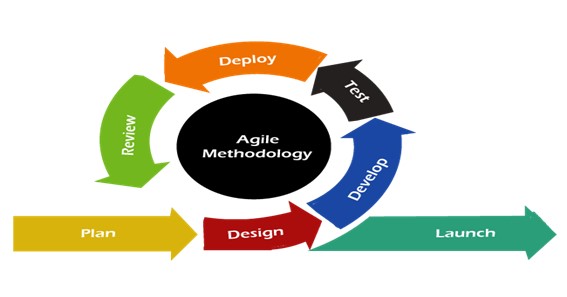Both Waterfall and Agile enjoy global popularity as suitable approaches for developing applications or organizing projects.
Waterfall’s conventional approach to project management involves a linear flow, whereas Agile follows iterative processes in which various lifecycle phases run in parallel.
The thing with the Waterfall approach is that you can embrace it if you want your projects tied to solid timelines and well-defined deliverables. It is a viable approach to go for if you are well-informed about your project’s major constraints or requirements.
What Is An Agile Project Management?
Agile methodology paves the path for a concurrent iteration of development and testing in the software development lifecycles. It permits effective communication flow between customers, developers, managers, and testers. Under this project management approach, the project release cycles appear a never-ending task and continue based on customer feedback.
Unlike the linear approach, Agile methodology helps developers adjust and iterate the development process, a flexibility that is immensely required in today’s era in which customers and businesses both hinge on rapid responses and transformations.
The viability of Agile project management extends to DevOps practices that advocate cohesion of development and operations teams in a software development cycle.
Click here – How to Plan an Interstate Move Soon and How to Hire a Removalist
Benefits Of The Agile Project Management Model
- It doesn’t ignore the client process which means, the client is involved during every stage of project development
- Teams following Agile methodology are extremely motivated and self-organized. Therefore, the chances for delivering better results in development projects are promising.
- This method assures quality development and the product’s better maintenance
- It allows both clients and the development team to remain informed of what is done and what remains; given Agile is based on incremental progress in the development process.
What Are The Agile Principles?
- A project based on Agile methodology is bifurcated into many incremental steps by incorporating feedback intervals.
- A project requirement is segregated into different tiny pieces to be prioritized according to their importance.
- It advocates collaboration with the customer.
- Planning and execution are well integrated into it, thus allowing teams to respond to any change in the requirements effectively.
Disadvantages Of Agile Project Management
- Not an ideal recommendation for small development projects
- Involves an expert responsible for taking key decisions in the meeting
- Expensive compared to other development methodologies
- Requires project manager’s clarity about the project’s final outcome or else it is fated to fall apart.
- Possible lack of clearly defined critical path and inter-project dependencies
- To establish true Agile execution with an iterate deployment pipeline pans out several tech dependencies and engineering expenses.
Click here – How Healthcare Translation Services Benefit Both Doctors and Patients
What Defines Waterfall Project Management?
Also known as Linear Sequential Life Cycle Model, the Waterfall methodology advocates sequential project development patterns, in which the next phase of development or testing is executed only after the successful execution of the previous step.
It sounds like an exact simulation of waterfall patterns defining a sequence of execution one after another one. Therefore, this approach to project management requires consecutive implementation of project phases involving completion or final approval of the previous stages.
It advocates linear and sequential formulas and can be a fitting solution to predictable, recurring processes. That said, if a project requires recurring processes that are predictable, the Waterfall approach is a suitable recommendation.
However, the way it hinges on sequential patterns causes great discomfort to development teams, leaving them clueless about how to adjust software development faster.
Waterfall Project Management – Benefits
- Minimum requirement for collaboration as it advocates sequential approval phases
- Clearly defines the dependencies of work
- Helps with cost predictability of the project
- It focuses on a more methodical and structured design phase
- Easily manageable model, as each phase goes through review process
- An ideal recommendation for smaller size projects with well-understood needs
- Ensures project is delivered faster
- Ensures documentation of process and results
- Helps manage dependencies
Disadvantages Of Waterfall Project Management
- Not an ideal recommendation for large size projects
- Turns out ineffective if the requirements are not well-understood in the beginning
- Extremely difficult to revert changes in the previous phases
- Since the testing process is initiated after the completion of development, any chance for fixing bugs later proves an expensive development cost
- Due to more specialized phase sequences, work is harder to be segmented and shared with teams
- Because of phase transitions causing delays and hurdles, it results in a waste of time and additional communication overhead
- Ownership and engagement regarding product maybe less strong compared to Agile.
Difference Between Agile & Waterfall Methodologies
| Agile | Waterfall |
|
|
|
|
|
|
|
|
|
|
|
|
|
|
Final Thoughts
Our comparative analysis between both Agile and Waterfall methodologies drives us to the conclusion that they are respectively valuable and can be used depending on your project’s exact requirements, goals, scopes, and your expectations.
Waterfall methodology is very traditional, dating back to the 1950s, and is pretty much tied to sequential phases, thereby making it a rigid software engineering approach in projects with clearly-defined requirements, and planning.
On the other hand, Agile methodology promotes a development ecosystem in which the goals and requirements regarding the development process are transparent and understood among developers and stakeholders.
Use the Waterfall method in specific tasks. Use the Agile method in processes that require iteration or continuous delivery. Yet, when it comes to job management, there is no one-size-fits-all solution.
Do you have an app idea waiting for coming into reality? We are a reputed software development company you can trust for your ambitious project development. We are the experts in Agile and Waterfall methodologies, as well as Cloud computing technologies to help you with futuristic software solutions. Schedule a call with us and grow boundlessly in your niche.






